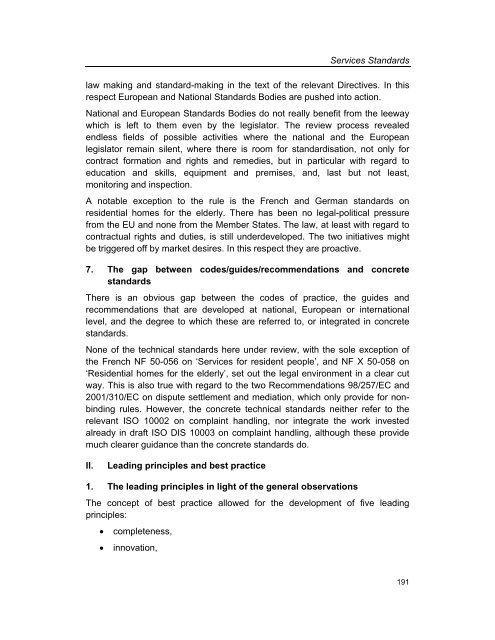Services Standards: Defining the Core Consumer Elements ... - ANEC
Services Standards: Defining the Core Consumer Elements ... - ANEC
Services Standards: Defining the Core Consumer Elements ... - ANEC
Create successful ePaper yourself
Turn your PDF publications into a flip-book with our unique Google optimized e-Paper software.
<strong>Services</strong> <strong>Standards</strong><br />
law making and standard-making in <strong>the</strong> text of <strong>the</strong> relevant Directives. In this<br />
respect European and National <strong>Standards</strong> Bodies are pushed into action.<br />
National and European <strong>Standards</strong> Bodies do not really benefit from <strong>the</strong> leeway<br />
which is left to <strong>the</strong>m even by <strong>the</strong> legislator. The review process revealed<br />
endless fields of possible activities where <strong>the</strong> national and <strong>the</strong> European<br />
legislator remain silent, where <strong>the</strong>re is room for standardisation, not only for<br />
contract formation and rights and remedies, but in particular with regard to<br />
education and skills, equipment and premises, and, last but not least,<br />
monitoring and inspection.<br />
A notable exception to <strong>the</strong> rule is <strong>the</strong> French and German standards on<br />
residential homes for <strong>the</strong> elderly. There has been no legal-political pressure<br />
from <strong>the</strong> EU and none from <strong>the</strong> Member States. The law, at least with regard to<br />
contractual rights and duties, is still underdeveloped. The two initiatives might<br />
be triggered off by market desires. In this respect <strong>the</strong>y are proactive.<br />
7. The gap between codes/guides/recommendations and concrete<br />
standards<br />
There is an obvious gap between <strong>the</strong> codes of practice, <strong>the</strong> guides and<br />
recommendations that are developed at national, European or international<br />
level, and <strong>the</strong> degree to which <strong>the</strong>se are referred to, or integrated in concrete<br />
standards.<br />
None of <strong>the</strong> technical standards here under review, with <strong>the</strong> sole exception of<br />
<strong>the</strong> French NF 50-056 on ‘<strong>Services</strong> for resident people’, and NF X 50-058 on<br />
‘Residential homes for <strong>the</strong> elderly’, set out <strong>the</strong> legal environment in a clear cut<br />
way. This is also true with regard to <strong>the</strong> two Recommendations 98/257/EC and<br />
2001/310/EC on dispute settlement and mediation, which only provide for nonbinding<br />
rules. However, <strong>the</strong> concrete technical standards nei<strong>the</strong>r refer to <strong>the</strong><br />
relevant ISO 10002 on complaint handling, nor integrate <strong>the</strong> work invested<br />
already in draft ISO DIS 10003 on complaint handling, although <strong>the</strong>se provide<br />
much clearer guidance than <strong>the</strong> concrete standards do.<br />
II.<br />
Leading principles and best practice<br />
1. The leading principles in light of <strong>the</strong> general observations<br />
The concept of best practice allowed for <strong>the</strong> development of five leading<br />
principles:<br />
• completeness,<br />
• innovation,<br />
191
















